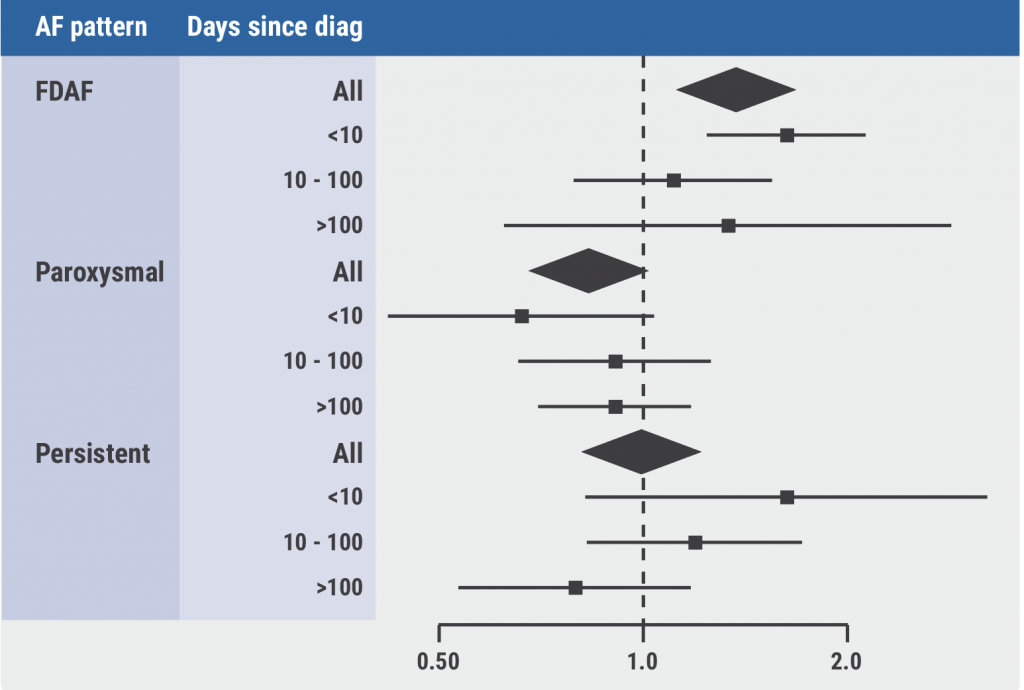EMPEROR-Preserved (NCT03057951) evaluated the efficacy and safety of the sodium-glucose co-transporter 2 (SGLT2) inhibitor empagliflozin compared with placebo in patients with HF with preserved ejection fraction (HFpEF) [1,2]. The trial included 5,988 patients with an LVEF >40%. Dr Stefan Anker (Charité University Berlin, Germany) presented the current analysis, which assessed the subset of included patients with truly preserved EF (≥50%) (n=4,005), in line with the recently updated ESC Guidelines on HF [3]. This analysis is relevant for trial comparisons and guideline recommendations. The primary outcome was a composite score of time to cardiovascular death or HF hospitalisation.
At 52 weeks, the primary endpoint of empagliflozin was met for patients with LVEF ≥50% (HR 0.83; P=0.024). The effect was driven by first HF hospitalisation (HR 0.78; P=0.013). No significant effect of empagliflozin was found on cardiovascular death, all-cause mortality, or cumulative HF hospitalisation (see Figure). The effect of empagliflozin on the primary endpoint in patients with an LVEF between 41% and 49% was numerically more pronounced (HR 0.71; P=0.002). Nonetheless, no interaction effect was observed between patients with LVEF ≥50% and patients with an LVEF ranging from 41% to 49% (P=0.27) regarding the primary outcome. A trend analysis did not reveal a significant trend of the effect of empagliflozin across 5% LVEF margins (50–55%, 55–60%, and so on up to >70%). The Kansas City Cardiomyopathy Questionnaire (KCCQ) demonstrated quality-of-life benefits of empagliflozin for patients with LVEF ≥50% (adjusted mean difference 4.24) compared with placebo (adjusted mean difference 2.78). Finally, empagliflozin receivers showed a significant and ongoing improvement on the New York Heart Association (NYHA) functional class score.
Figure: Primary and secondary outcomes for LVEF ≥50% [1]

CI, confidence interval; CV, cardiovascular; HHF, hospitalisation for heart failure; HR, hazard ratio; LVEF, left ventricular ejection fraction.
Dr Anker highlighted that the 17% reduction on the primary clinical endpoint in this study is remarkable compared with other pharmaceutical interventions for patients with HFpEF assessed in previous clinical trials. “Prior clinical trials showed efficacy rates between 4–8%. Thus, empagliflozin is the first agent to demonstrate a meaningful effect in HF patients with truly preserved EF in a large-scale trial.”
- Anker SD, et al. Empagliflozin in Heart Failure With a Preserved Ejection Fraction ≥50% – Results From the EMPEROR-Preserved Clinical Trial. LBS05, AHA Scientific Sessions 2021, 13–15 November.
- Anker SD, et al. N Engl J Med 2021;385:1451–1461.
- McDonagh TA, et al. Eur Heart J 2021;42(36):3599–3726.
Copyright ©2021 Medicom Medical Publishers
Posted on
Previous Article
« EMPULSE: Empagliflozin improves outcomes of acute heart failure Next Article
Distinguishing patients before AMI based on plaque morphology »
« EMPULSE: Empagliflozin improves outcomes of acute heart failure Next Article
Distinguishing patients before AMI based on plaque morphology »
Table of Contents: AHA 2021
Featured articles
The scope of remote healthcare in hypertension and hyperlipidaemia
Atrial Fibrillation
New developments in remote diagnostics and monitoring of AF
Head-to-head: Efficacy of dabigatran versus warfarin on cognitive impairment
Posterior left pericardiotomy safe and effective in reducing atrial fibrillation
LAA ligation did not reduce recurrent atrial arrhythmias in persistent AF
Equal benefits of early rhythm control in AF subtypes
CVD Risk Reduction
Remote healthcare programme improves hypertension and lipid control
Novel oral PCSK9 inhibitor shows promising results for hypercholesterolaemia
REVERSE-IT: Interim analysis shows promising effect of bentracimab on ticagrelor reversal
No significant effect of aspirin on reducing cognitive impairment
Milvexian phase 2 data supports safety and efficacy for VTE prevention after total knee replacement
Network meta-analysis observes no clear effect of eicosapentaenoic acid on CV outcomes
Heart Failure
Empagliflozin efficacious in HF patients with preserved ejection fractions ≥50%
EMPULSE: Empagliflozin improves outcomes of acute heart failure
CHIEF-HF: Canagliflozin improves health status in heart failure
DREAM-HF: MPC therapy for HFrEF did not meet primary endpoint
Therapeutic approaches in heart failure with diabetes
Acute Coronary Syndrome
Ticagrelor cessation: early CABG non-inferior to delayed surgery
Distinguishing patients before AMI based on plaque morphology
Vascular Diseases: PVD
Rivaroxaban regimen beneficial after revascularisation for claudication
LIBERTY 360 shows quality-of-life improvements after peripheral vascular intervention
Deficient treatment outcomes after PVI in Black and low-income adults with PAD
REDUCE-IT: Cardiovascular risk reduction with icosapent ethyl in PAD
Vascular Diseases: CAD
Long-term reduced risk of CV events with ticagrelor plus aspirin after CABG
Early surgery outperforms conservative management in asymptomatic severe aortic stenosis
External support device for SVG grafts in CABG surgery shows promise
COVID-19 & the Heart
Blood pressure control disrupted during the pandemic
Icosapent ethyl did not reduce the risk of hospitalisation in COVID-19
Neutral effect of P2Y12 inhibitors in non-critical COVID-19 hospitalisations
COVID-19 mRNA vaccination benefits outweigh the risk for myocarditis
Other
2021 Guideline for Chest Pain: Top 10 takeaways
Accurate ejection fraction assessment in paediatric patients via artificial intelligence
Concomitant tricuspid annuloplasty reduces treatment failure in moderate tricuspid regurgitation
Related Articles

January 14, 2022
Equal benefits of early rhythm control in AF subtypes
January 14, 2022
No significant effect of aspirin on reducing cognitive impairment
January 14, 2022
Therapeutic approaches in heart failure with diabetes
© 2024 Medicom Medical Publishers. All rights reserved. Terms and Conditions | Privacy Policy
HEAD OFFICE
Laarderhoogtweg 25
1101 EB Amsterdam
The Netherlands
T: +31 85 4012 560
E: publishers@medicom-publishers.com

